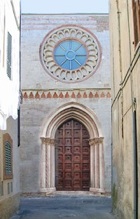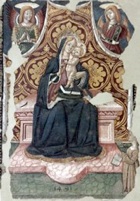
A community of Poor Clares that was established outside the walls in 1225 moved here in 1290 and subsequently built the present church. This community was suppressed in 1860, although it re-appeared in 1887 at the Monastero di Santa Caterina Nuova.
After more than a century of disuse, the church has recently (2011) been restored for secular purposes. The nunnery has been demolished to make way for a school.
Frescoes in the Church
Scenes from the life of Christ (late 14th or early 15th century)
This fresco cycle, which survives on the right wall of the presbytery, is attributed to the Maestro dell' Abside Destra di San Francesco di Montefalco.
Frescoes from the Church
The following are works from the church are now in the Pinacoteca Civica:
Martyrdom of St Barbara (1449)

This composite fresco, which is signed by Bartolomeo di Tommaso and dated, was probably commissioned in thanks for the delivery of the city (or perhaps the donor) from the plague. It was detached in 1873.
-
✴In the main scene, Santa Barbara is scalped and a group of kneeling nuns bear witness while shepherds survey a plague of locusts in the background.
-
✴The subsidiary scenes depict:
-
•the Madonna di Loreto with angels; and
-
•St Antony of Padua.
-
In each of these, a single kneeling nun (presumably the donor) says her rosary.
Madonna and Child enthroned (1491)

Martyrdom of St Catherine of Alexandria (16th century)
This detached fresco which is attributed to Dono Doni, came from the nunnery. In the main scene, a grinning executioner beheads St Catherine in front of the Emperor. The frescoed lunette depicts St Catherine in glory.



